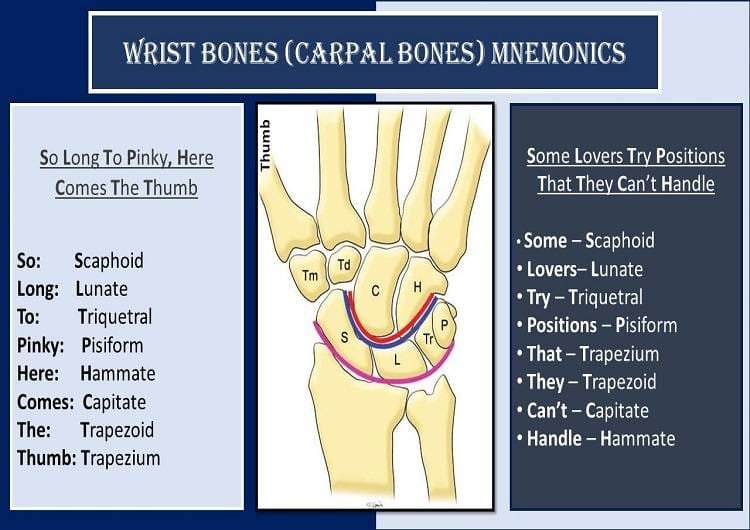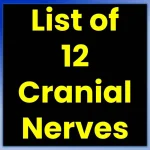What is the easiest way to remember all the wrist bones or carpal bones in order? Today’s topic is all about the carpal bones mnemonic or wrist bones mnemonics. Stay connected.
How Many Carpal Bones Are There?
There are 8 short bones that connect the forearm and the hand. These bones are known as carpals or carpal bones. They form the carpus or wrist. So, they are also called wrist bones. The word “carpal” is derived from a Latin and Greek word meaning “wrist”.
The names of these wrist bones are strange to hear as they are named based on the ancient names of their shapes.
Wrist Bones (Carpal Bones) Names in Order
The carpal bones are arranged in two rows. The first row is proximal to the radius and ulna and the second row lies close to the metacarpal bones of the hand.
Proximal Row (radial to ulnar)
- Scaphoid (boat-shaped): It is the most commonly fractured carpal bone
- Lunate (moon-shaped)
- Triquetral (pyramid-shaped)
- Pisiform (pea-shaped): It is the smallest carpal bone
Distal row (radial to ulnar):
- Trapezium (Table-shaped with one side parallel)
- Trapezoid (Table-shaped with no sides parallel): It is the smallest carpal bone in the distal row
- Capitate (head-shaped): It is the largest carpal bone
- Hamate (having hook/hamulus)
Mnemonics for Carpal Bones
What is the easiest way to remember the names of all carpal bones in order? The suitable answer to this question is the carpal bones mnemonic or memory trick.
There are several mnemonics to remember the names and order of the carpal bones. Three popular, funny, and dirty mnemonics for carpal bones are mentioned here.
Pick whichever mnemonic you find handy. You can also modify these mnemonics to make them more effective for your reading environment.
Two types of mnemonics are common to remember wrist bones: one describes the position of the carpal bones from the radial to the ulnar side, for both rows, proximal than distal, and the other starting with the proximal row from the scaphoid towards the pinky (small finger) and then the distal row starting from the hamate towards the thumb.

First Carpal Bones Mnemonic (Here Comes The Thumb)
These carpal bones mnemonics name the wrist bones in a cyclic pattern, starting with the proximal row from the scaphoid towards the pisiform (radial to ulnar), and then the distal row commencing from the hamate towards the trapezium (ulnar to radial).
- Straight Line To Pinky, Here Comes The Thumb
- So Long To Pinky, Here Comes The Thumb
Second Carpal Bones Mnemonic (Some Lovers-Scrubs)
These carpal bones mnemonics name the wrist bones from the radial to ulnar side. The proximal row starts from the scaphoid towards the pisiform (radial to ulnar), and then the distal row commences from the trapezium towards the hamate (radial to ulnar).
- Some Lovers Try Positions, That They Can’t Handle
The modified versions of the above mnemonic are:
- She Looks Too Pretty, Try To Catch Her
- Sally Left The Party, To Take Cathy Home
- Sam Likes To Push, The Toy Car Hard
- She Loves To Play, Try To Catch Her
The modified, dirty mnemonic for carpal bones:
- “Scottish Lads Take Prostitutes To The Caledonian Hotel”:
The problem with these mnemonics is the two “T”s in the distal row both starting from “Trapez-“.
This can be remembered using another simple trick:
- Trapez-ium: Towards thumb
- Trapez-oid: On it’s side or Inside
Third Wrist Bones Mnemonic
Start with the trapezium bone, and go in a clockwise direction using the following mnemonic: To Save Lives, The Physician Helps Create Treatments.
- To = Trapezium
- Save = Scaphoid
- Lives = Lunate
- The = Triquetral
- Physician = Pisiform
- Helps = Hamate
- Create = Capitate
- Treatments = Trapezoid
Thus, if you are looking at an anterior view of the right hand, you begin with the trapezium at the thumb’s metacarpal, go in a clockwise direction, and end at the trapezoid with this mnemonic.
Definition of Mnemonic
A mnemonic or a memory aid is defined as a tool that assists us to remember particular facts or a large quantity of information. Mnemonics are in the form of songs, phrases, sentences, rhymes, acronyms, images, poems, outlines, or other tools.
They help us remember facts and important information, and are particularly useful when the order and chronology of things and events are important.
Merriam-Webster Dictionary defines a mnemonic as a technique for improving memory. Mnemonic (pronounced ni-mon-ik) is derived from the Greek phrase mimnēskesthai meaning to “remember.
Most of the mnemonics are acronyms or initialisms which reduce a lengthy set of terms to a single, easy-to-remember word or phrase.
Medical Mnemonics
Mnemonics are extensively used in the field of medicine. They are handy tools to memorize any important information from anatomy, physiology, biochemistry, pathology to pharmacology.
Medical, nursing and paramedical students have to do so much of the study-related work in little time. They don’t even get enough time to review for quarterly and board exams. They are forced to memorize a whole lot of information in no time.
In such hard times come medical acronyms and medical mnemonics to relieve the pain of medical students.
Carpal bones mnemonic or memory trick helps students to remember all the wrist bones’ names in order. First, get some information about the wrist bones and their names in order, then we will dive into the carpal bones mnemonic.
YOU MAY ALSO LIKE
Beck’s Triad in Cardiology: Mnemonic, Treatment & More
Cushing’s Triad in ICP: Pathophysiology, Mnemonic, & More





